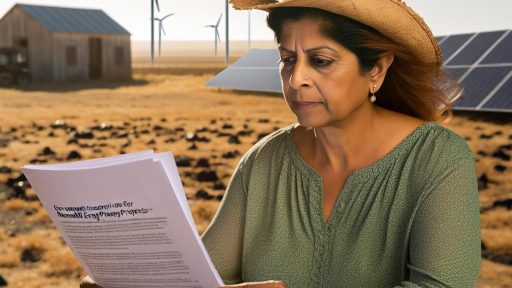Overview of Renewable Energy and Its Importance in Agriculture
Understanding Renewable Energy
Renewable energy comes from natural sources that replenish themselves.
This includes solar, wind, and biomass energy.
These resources are crucial in combating climate change.
Farmers increasingly adopt these technologies for sustainability.
Benefits for Farmers
Renewable energy lowers operational costs significantly.
Farmers can produce their own energy on-site.
This reduces dependence on traditional energy sources.
Additionally, using renewable resources improves farm resilience.
Environmental Impact
Renewable energy reduces greenhouse gas emissions.
It also minimizes the carbon footprint of agricultural operations.
Farming can thus become a part of the climate solution.
Government Programs and Incentives
Various government initiatives support the adoption of renewable energy.
Programs offer grants or subsidies for installation of solar panels.
Farmers can also access low-interest loans for energy efficiency upgrades.
These incentives make transitioning to renewable energy more feasible.
Transform Your Agribusiness
Unlock your farm's potential with expert advice tailored to your needs. Get actionable steps that drive real results.
Get StartedFuture Trends
The agricultural sector is likely to see more innovation in renewable energy.
Emerging technologies will enhance energy efficiency.
Farmers will continue to integrate renewable solutions as they become more viable.
This trend is essential for ensuring long-term sustainability.
Federal and State Incentives for Renewable Energy Adoption
Understanding the Importance of Incentives
Incentives play a crucial role in promoting renewable energy adoption among farmers.
They can significantly lower the initial investment costs involved in renewable energy systems.
Moreover, these incentives often come in the form of tax credits, grants, or loans.
Farmers can leverage these opportunities to enhance their sustainability practices.
Federal Incentives Available
The federal government offers a range of programs to support renewable energy adoption.
One of the most prominent programs is the Investment Tax Credit (ITC).
This program allows farmers to deduct a significant percentage of their renewable energy system costs from their federal taxes.
Additionally, the USDA provides grants and loan guarantees through programs like the REAP.
These resources are specifically designed for farmers investing in renewable energy projects.
State-Level Incentives
Many states have their own incentive programs that can complement federal offerings.
States often provide additional tax credits or rebates for renewable energy installations.
For instance, California offers the California Solar Initiative, which provides rebates for solar installations.
Other states may have specific programs aimed at promoting wind energy or bioenergy.
Farmers should research local guidelines to identify available options.
Grants and Loans from USDA
The U.S. Department of Agriculture administers various financial assistance programs.
These include the Rural Energy for America Program (REAP), which benefits agricultural producers.
Through REAP, eligible applicants can access grants and guaranteed loans for energy improvements.
These funds can be used for purchasing renewable energy systems, like solar panels and wind turbines.
How to Access These Incentives
Accessing these incentives typically involves some paperwork and applications.
Farmers should gather relevant documentation, including project plans and financial statements.
Showcase Your Farming Business
Publish your professional farming services profile on our blog for a one-time fee of $200 and reach a dedicated audience of farmers and agribusiness owners.
Publish Your ProfileAdditionally, deadlines for applications can vary, so it’s crucial to stay informed.
Consulting with agricultural extension services can provide valuable assistance.
Staying Updated on Changes
Renewable energy programs and incentives can change frequently.
Farmers should regularly check for updates from state and federal agencies.
Subscriptions to newsletters from the USDA and local agricultural organizations can help.
Staying informed ensures farmers do not miss out on available funding opportunities.
Solar Energy Programs: Benefits and Implementation for Farmers
Introduction to Solar Energy
Solar energy presents a viable option for farmers seeking sustainable energy solutions.
This renewable resource harnesses sunlight to generate electricity or heat.
Benefits of Solar Energy for Farmers
Implementing solar energy provides several advantages for agricultural operations.
Firstly, it reduces reliance on fossil fuels, lowering operational costs.
Additionally, solar energy can decrease electricity bills significantly.
Farmers can also benefit from various tax incentives and subsidies.
Moreover, solar installations can enhance farm sustainability and resiliency.
Understanding Solar Energy Programs
Numerous programs offer assistance to farmers interested in solar energy.
These programs can vary by state and federal guidelines.
Federal Programs
The USDA provides the Rural Energy for America Program (REAP).
This initiative supports renewable energy projects through grants and loans.
Additionally, the Investment Tax Credit (ITC) offers significant tax savings for solar installations.
State Programs
Many states offer their own incentive programs for solar energy adoption.
These may include rebates, grants, or performance-based incentives.
Farmers should research local programs to maximize financial benefits.
Implementing Solar Energy Systems
Farmers must consider several factors when implementing solar systems.
First, evaluate the farm’s energy needs and usage patterns.
Next, assess the suitable size and type of solar system to install.
Process of Installation
Choosing a reliable solar installation company is crucial for success.
After selecting a provider, they will conduct a site assessment.
This assessment helps determine the best location for solar panels.
Financing Options
Farmers have various financing options available for solar investments.
These can include cash purchases, loans, and leasing agreements.
Understanding these options is vital for making informed decisions.
Benefits of Adopting Solar Energy
Solar energy programs offer numerous advantages for farmers.
They promote sustainability while providing financial benefits.
Exploring these options can lead to long-term positive impacts on agricultural operations.
Gain More Insights: Understanding Agricultural Insurance Policies for Farmers
Wind Energy Solutions: Assessing Feasibility for Agricultural Land
Introduction to Wind Energy for Farming
Wind energy increasingly attracts attention in the agricultural sector.
This renewable energy source can provide sustainable power to farms.
Farmers can lower their energy costs significantly by utilizing wind power.
Additionally, wind energy can diversify income sources for agricultural operations.
Evaluating Wind Resources
The first step is assessing the wind potential on the farm.
Farmers should analyze historical wind data specific to their location.
Showcase Your Farming Business
Publish your professional farming services profile on our blog for a one-time fee of $200 and reach a dedicated audience of farmers and agribusiness owners.
Publish Your ProfileThey can obtain this data from local meteorological stations or online databases.
Wind vectors and seasonal variations play critical roles in feasibility.
If the average wind speed exceeds certain thresholds, it may be viable to invest.
Site-specific Considerations
Every farm has unique physical attributes affecting wind turbine placement.
Topography, land use, and existing structures can influence wind patterns.
Farmers should also consider potential environmental impacts of installation.
Proximity to residential areas may raise noise and aesthetic concerns as well.
Permitting and Regulations
Navigating local regulations is essential for wind energy projects.
Farmers need to obtain necessary permits before installation.
Collaboration with local authorities is advisable to ensure compliance.
Understanding zoning laws can minimize delays in project implementation.
Financial Incentives and Support
Various financial incentives are available for farmers investing in wind energy.
These may include grants, tax credits, and low-interest loans.
Programs like the USDA’s Rural Energy for America Program offer significant support.
Farmers can also explore partnerships with renewable energy firms for funding.
Long-term Economic Benefits
Investing in wind energy can yield substantial long-term savings.
Reducing dependency on fossil fuels mitigates exposure to energy price fluctuations.
Additionally, wind energy can enhance the resilience of farming operations.
Some farmers earn extra income by selling excess energy back to the grid.
Next Steps for Farmers
Farmers interested in wind energy must begin by assessing their land.
Engaging industry experts can provide valuable insights into feasibility.
Furthermore, educating themselves on financial options ensures informed decisions.
With proper planning, wind energy can become a vital asset for agriculture.
See Related Content: Navigating International Trade Agreements For Agricultural Success
Biogas Production: How Farmers Can Utilize Waste for Energy
Understanding Biogas Production
Biogas production converts organic waste into renewable energy.
This process creates energy-rich gas, primarily methane.
Farmers can harness this process to improve sustainability.
Sources of Organic Waste
Many sources of organic waste exist on farms.
Common sources include animal manure, crop residues, and food scraps.
Utilizing these materials reduces waste and creates energy.
Steps for Implementing Biogas Systems
Implementing a biogas system involves several steps.
First, farmers should assess their waste sources.
Next, they can design a biogas digester suitable for their needs.
After installation, proper maintenance ensures efficient operation.
Benefits of Biogas Production
Biogas production offers multiple benefits for farmers.
- Reduces reliance on fossil fuels.
- Provides a sustainable energy source.
- Produces nutrient-rich fertilizer as a byproduct.
- Minimizes greenhouse gas emissions.
Financing Biogas Projects
Farmers can explore various financing options for biogas systems.
Government grants and incentives often support renewable energy projects.
Private investors also seek opportunities in sustainable agriculture.
Researching local and national programs can provide financial help.
Common Challenges and Solutions
Biogas systems can encounter several challenges.
Showcase Your Farming Business
Publish your professional farming services profile on our blog for a one-time fee of $200 and reach a dedicated audience of farmers and agribusiness owners.
Publish Your ProfileOne common issue is the initial investment cost.
Farmers can mitigate this by seeking grants or partnerships.
Additionally, managing digester operations may require training.
Participating in workshops or farmer networks can provide valuable knowledge.
You Might Also Like: Farm-To-Table Regulatory Requirements Every Farmer Should Know

Energy Efficiency Programs: Reducing Consumption on the Farm
Introduction to Energy Efficiency
Energy efficiency programs help farmers reduce consumption effectively.
These programs promote sustainable practices on the farm.
By implementing energy-saving measures, farmers can lower operational costs.
Understanding Energy Audits
An energy audit assesses how energy is used on the farm.
This process identifies areas for improvement in efficiency.
Auditors provide specific recommendations tailored to each farm.
By following these recommendations, farmers can make informed decisions.
Incentives for Energy Efficiency Upgrades
Farmers can access various financial incentives.
These incentives reduce the upfront costs of upgrades.
Government programs often include rebates and grants.
Private organizations also support energy efficiency initiatives.
This financial assistance encourages more farmers to invest in efficiency.
Renewable Energy Integration
Integrating renewable energy sources enhances energy efficiency.
Solar panels are a popular option for farms seeking sustainability.
Wind turbines can also provide significant energy savings.
Utilizing renewable energy reduces dependence on fossil fuels.
This approach promotes both economic and environmental benefits.
Monitoring and Evaluation
Ongoing monitoring ensures energy efficiency measures are effective.
Farmers should track their energy usage after implementing changes.
Regular evaluations can highlight further areas for improvement.
Adapting to new technologies can also enhance efficiency.
Continuous improvement is key to long-term success in energy efficiency.
Learn More: Ensuring Crop Safety Through Food Safety Standards
Integrating Renewable Energy with Traditional Farming Practices
Understanding Renewable Energy Options
Farmers now have access to various renewable energy sources.
Solar, wind, and bioenergy are popular choices.
Each option works differently, catering to specific farm needs.
Understanding these technologies is essential for successful integration.
Benefits of Renewable Energy in Farming
Integrating renewable energy can reduce operational costs.
Farmers can generate their own electricity sustainably.
This practice decreases dependence on fossil fuels.
Furthermore, it can enhance farm resilience against energy price fluctuations.
Renewable energy also decreases carbon footprints, promoting environmental sustainability.
Solar Energy Integration
Solar panels are a versatile option for farmers.
They can provide power for irrigation systems and buildings.
Farmers can also sell excess energy back to the grid.
Showcase Your Farming Business
Publish your professional farming services profile on our blog for a one-time fee of $200 and reach a dedicated audience of farmers and agribusiness owners.
Publish Your ProfileCommunity solar projects offer shared benefits for small-scale farmers.
Wind Energy Applications
Wind turbines can generate significant energy on farms with ample space.
The height and efficiency of modern turbines facilitate energy conversion.
Farmers should assess wind patterns to identify feasible installation sites.
Local regulations can influence turbine placement and operation.
Bioenergy Opportunities
Bioenergy utilizes organic waste to produce energy.
Farmers can convert crop residues and livestock manure into biogas.
This process reduces waste while creating a renewable energy source.
Moreover, it can provide additional income streams through energy sales.
Government Incentives and Programs
Many governments offer incentives for renewable energy adoption.
These incentives may include grants, tax credits, and low-interest loans.
Farmers should research local programs that support renewable energy projects.
Participating in these programs can significantly lower initial costs.
Step-by-Step Implementation Process
Farmers should start by assessing their energy needs.
Next, conduct feasibility studies for different renewable options.
This analysis will help determine the best energy solution for the farm.
Subsequently, create a plan for installation and integration.
Finally, evaluate the performance regularly to ensure optimal operation.
Success Stories: Case Studies of Farmers Using Renewable Energy Solutions
Transforming Farms with Solar Energy
James Martinez runs a successful vineyard in California.
He adopted solar panels to decrease his energy bills.
This choice significantly lowered his operational costs.
Moreover, James became energy independent.
His solar panels generate enough energy to power his entire farm.
As a result, he invests savings back into his business.
Additionally, solar energy has a positive environmental impact.
James’s story demonstrates practical benefits for farmers.
Wind Power in the Midwest
Susan Green operates a grain farm in Nebraska.
She implemented small wind turbines on her property.
Her turbines generate electricity for her machinery and homes.
This decision significantly reduced her reliance on the grid.
Plus, Susan sells excess energy back to the local utility.
The community benefits from her sustainable energy initiative.
Her story inspires other farmers to consider wind energy options.
Harnessing Biogas for Sustainable Growth
The Johnson family manages a livestock farm in Wisconsin.
They installed a biogas digester to manage waste effectively.
This system converts manure into valuable energy.
The biogas powers their operations and heats buildings.
Additionally, they use the byproduct as organic fertilizer.
It reduces waste and benefits soil health significantly.
As a result, their farm is more sustainable and profitable.
Showcase Your Farming Business
Publish your professional farming services profile on our blog for a one-time fee of $200 and reach a dedicated audience of farmers and agribusiness owners.
Publish Your ProfileThis case showcases the potential of biogas for farmers.
Utilizing Geothermal Energy in Greenhouses
Maria Lopez runs a greenhouse operation in Oregon.
She leverages geothermal energy for heating her plants.
This method provides consistent temperatures year-round.
Consequently, Maria increases her crop yields.
Moreover, geothermal energy is environmentally friendly.
Her success emphasizes the advantages of alternative heating methods.
Other greenhouse operators are considering similar technologies.
Community Solar Projects
The local farming co-op in Minnesota approached solar energy together.
They partnered with a renewable energy company to install solar farms.
Each farmer benefits from the energy produced at a reduced cost.
This collaborative project strengthens community ties.
Additionally, it provides an opportunity for shared savings.
Farmers are now advocates for renewable energy in their area.
This example illustrates the impact of teamwork in sustainability.
Additional Resources
What is the Farm Bill? – National Sustainable Agriculture Coalition




